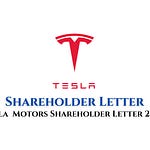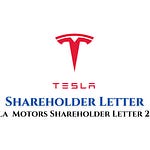Here's a detailed briefing document reviewing the main themes and most important ideas or facts from the provided Tesla shareholder letters for Q1, Q2, Q3, and Q4 2015:
Tesla Motors: 2015 Shareholder Briefing
Sources: Tesla Motors – First Quarter 2015 Shareholder Letter
Tesla Motors, Inc. – Second Quarter 2015 Shareholder Letter
Tesla Motors, Inc.– Third Quarter 2015 Shareholder Letter
Tesla Motors, Inc.– Fourth Quarter & Full Year 2015 Shareholder Letter
Executive Summary
2015 was a pivotal year for Tesla, marked by significant product expansion, increased production and deliveries, and strategic foundational work for future growth. Key highlights include the launch of the Model X SUV and the global release of Autopilot features, alongside the initiation and acceleration of Tesla Energy product production at the Gigafactory. The company saw strong demand for its Model S globally, despite increasing competition, and continued to invest heavily in manufacturing capacity, R&D for future products like Model 3, and global sales and service infrastructure. While achieving record production and delivery numbers, profitability remained a challenge due to launch costs and increased investments.
Key Themes and Developments
1. Product Expansion and Innovation:
Model X Launch: The highly anticipated Model X, Tesla's third vehicle, launched in Q3 2015, with initial deliveries commencing. It is highlighted as "featuring a combination of safety, performance and convenience that is unmatched by any other sport utility vehicle (SUV)." The Model X aims to demonstrate "that any vehicle type can be successfully electrified, even a large SUV that seats seven adults, carries all their gear and can tow up to 5,000 lbs." Its unique features include "falcon wing doors," a "panoramic windshield," and an estimated EPA range of up to 257 miles for the 90kWh pack. Internal crash testing indicated it should receive "the best ever safety ratings for an SUV." Reservations converted to firm orders at a "much higher rate than we witnessed with Model S."
Autopilot Rollout: A significant software update released in Q3 and Q4 enabled "Autopilot on about 40,000 Model S and Model X vehicles globally." This beta release offers features such as "steer within a lane, change lanes with a tap of a turn signal and parallel park autonomously," and is designed to "improve over time," marking an "important step toward a future of autonomous driving." By year-end, Tesla Autopilot was "learning at the rate of over a million real-world miles per day."
Model S Enhancements and Variants: Throughout 2015, Tesla continued to expand the Model S lineup.
Q1 saw the launch of the "All-Wheel Drive Model S 85D and 70D."
In Q2, Tesla introduced the more affordable "Model S 70" (starting at $70,000 before incentives) and a new "90kWh battery pack option" increasing the range of the 85D by 6%.
For performance enthusiasts, "Ludicrous mode" was introduced, dramatically improving 0-60 mph acceleration to 2.8 seconds, with an upgrade option for existing P85D customers.
Over-the-air software updates continued to enhance existing Model S vehicles, adding "new active safety capabilities, intelligent range and charge management features, and boosting performance."
2. Production and Delivery Growth:
Record Production and Deliveries: Tesla achieved record production and delivery numbers throughout 2015.
Q1: Produced 11,160 vehicles (exceeding plan), delivered 10,045 vehicles.
Q2: Produced 12,807 vehicles (exceeding target), delivered 11,532 vehicles.
Q3: Produced a record 13,091 vehicles (despite a one-week shutdown), delivered a record 11,603 vehicles.
Q4: Contributed to a total of 50,000 to 52,000 deliveries for the year.
2015 Full Year Deliveries: Total Model S deliveries for 2015 reached 25,202, a 51.01% increase from 2014.
2016 Outlook: Tesla projected to "deliver 80,000 to 90,000 new Model S and Model X vehicles in 2016." The company is "highly confident of average production and deliveries of 1,600 to 1,800 vehicles per week for Model S and Model X combined during 2016."
Manufacturing Efficiency and Challenges: The company focused on improving manufacturing efficiency and reducing per unit costs. While production goals were often met or exceeded, the Model X ramp in Q4 faced constraints, primarily "the supply of components related to the second row monopost seats." To address this, Tesla "brought manufacturing of these seats in-house." This added "uncertainty to our build plans during Q4," but Tesla emphasized "emphasizing quality is the right decision for our customers."
3. Expanding Demand and Market Penetration:
Strong Model S Demand: Global Model S orders increased significantly year-over-year in all major regions.
Q2 Model S orders grew almost 30% year-over-year in the U.S. and over 50% in Europe.
In China, Q3 Model S orders "increased substantially from Q2," partly due to new retail locations and policy changes allowing Tesla buyers to bypass license plate restrictions.
In Q4, Model S continued to gain market share globally, becoming "the number one selling comparably priced four-door sedan" in the U.S. and outselling major luxury competitors in Switzerland and Germany.
Model X Market Expansion: Tesla believes Model X "expands the market for Tesla vehicles, with little to no cannibalization of Model S," as order rates accelerated for both models after the Model X launch.
Customer Programs: New programs like the referral program (where both referrer and referred receive $1,000) and the pre-owned car program were introduced to "expose more people to the benefits of driving electric vehicles." The pre-owned program leverages the Model S's high residual value and offers a new 4-year warranty.
Network Expansion: Tesla continued to expand its global network of stores, service centers, and Supercharger locations. By Q1, there were "425 Supercharger locations and 100 service locations globally."
4. Tesla Energy and Gigafactory Development:
Tesla Energy Launch: Tesla launched its new "Tesla Energy business" in Q1 2015, introducing "a suite of energy storage products." Production of Powerpacks and Powerwalls began in Q3 at the Fremont factory, with strong demand globally, especially in Australia, Germany, and South Africa.
Gigafactory Acceleration: The Gigafactory construction and production were "ahead of schedule." In early Q4, Tesla "accelerated our plans to expand manufacturing capacity" by relocating Tesla Energy production to an automated assembly line at the Gigafactory sooner than initially planned. Plans were also accelerated to begin "cell production for Tesla Energy products at the Gigafactory by the end of 2016," several quarters ahead of the initial schedule. This facility is crucial, as "Both our vehicle and Tesla Energy businesses will benefit from our Gigafactory project, which should start producing initial quantities of battery packs in 2016."
Supply Chain for Gigafactory: Conditional purchase orders for lithium hydroxide were signed "to promote sourcing of this commodity at lower cost and with reduced environmental impact," with plans for further supplier arrangements.
5. Financial Performance and Outlook (Non-GAAP Focus):
Revenue Growth: Tesla saw strong year-over-year revenue growth.
Q1 Non-GAAP Revenue: $1.10 billion (up 55% YoY).
Q2 Non-GAAP Revenue: $1.20 billion (up nearly 40% YoY).
Q3 Non-GAAP Revenue: $1.24 billion.
Q4 Non-GAAP Revenue: $1.75 billion.
Full Year 2015 Non-GAAP Revenue: $5.29 billion.
Gross Margin: Tesla aimed for and largely achieved its gross margin targets, though there were fluctuations due to product mix shifts, strong dollar impact, and launch expenses.
Q1 non-GAAP automotive gross margin (excluding ZEV credits) was 26.0%.
Q2 non-GAAP automotive gross margin (excluding ZEV credits) was 23.9%, slightly below guidance due to higher manufacturing costs and deferred Autopilot revenue recognition.
Q4 Model S gross margin was expected to improve sequentially, but Model X launch expenses and higher overhead were projected to temporarily depress overall non-GAAP Automotive gross margin.
Expected Model X gross margin to "improve rapidly and become comparable to Model S gross margin over the next several quarters" after production stabilizes in Q1 2016.
Operating Expenses: Operating expenses increased as the company invested in R&D (including Model 3 development) and expanded its global sales capabilities. However, in Q1, operating expenses grew "at a slower rate than expected."
Capital Expenditures: Planned capital expenditures for 2015 were approximately $1.7 billion (increased from initial $1.5 billion), driven by "accelerated investments in the Gigafactory, further vertical integration of seat assembly and other manufacturing activities, as well as faster milestone execution by certain suppliers for Model X manufacturing equipment and tooling."
Profitability: Tesla consistently reported net losses on a GAAP basis throughout 2015, reflecting heavy investments in growth. The company emphasizes non-GAAP measures which align revenue and cost recognition with cash collection, stating "Our non-GAAP measures align the recognition of revenues and costs related to a vehicle sale with the time when the customer take delivery of the car and cash is received or owed to us."
Model 3 Unveiling: The unveiling of the Model 3 was planned for "late March 2016," with first deliveries expected in late 2017.
Important Ideas/Facts
Mission-Driven: Tesla's overarching mission is "accelerating the world’s transition to sustainable transportation." This is emphasized not only through electric vehicles but also the new Tesla Energy business, which "provide[s] an achievable pathway to a 100% zero carbon energy system."
Focus on Quality Over Quarterly Numbers: When facing production challenges with Model X, Tesla explicitly stated, "Simply put, in a choice between a great product or hitting quarterly numbers, we will take the former. To build long-term value, our first priority always has been, and still is, to deliver great cars."
Software-Defined Vehicles: The ability to deliver "over-the-air software updates" is a core differentiator, allowing Tesla to "improve customer cars over time" by adding new features and boosting performance (e.g., Autopilot, acceleration improvements).
Electrification and Autonomous Driving as Crucial: Tesla views "Vehicle electrification and autonomous driving are crucial to sustainable and safe personal transportation; plus these technologies make driving more enjoyable."
Model S Market Leadership: The Model S became the "number one selling comparably priced four-door sedan" in the U.S. and outperformed established luxury brands in key European markets.
Total Miles Driven: By Q3 2015, Tesla customers had driven "almost 250 million miles this quarter, for a total of nearly 1.5 billion miles to date." By year-end, total miles driven reached "nearly 2 billion miles." This vast amount of real-world driving data is crucial for Autopilot's learning capabilities.
Gigafactory as a Key Enabler: The Gigafactory is not just for vehicles but also for Tesla Energy products, enabling significant scaling and cost reduction for batteries, described as an "enormous" addressable market that is "much easier to scale globally than vehicle sales."
Lease Accounting Impact: Tesla's financial reporting (both GAAP and non-GAAP) is significantly impacted by lease accounting for vehicles with resale value guarantees, which defers revenue recognition. The company provides a detailed reconciliation to illustrate its non-GAAP approach.














Share this post